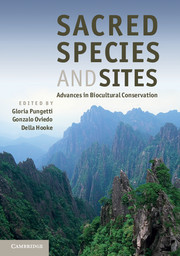Book contents
- Frontmatter
- Contents
- List of Contributors
- Foreword
- Preface
- Acknowledgements
- Introduction
- Part I Concepts and Knowledge
- Part II Sacred Landscapes
- Part III Sacred Sites and People
- Part IV Sacred Species
- Part V Sacred Animals
- 17 Genealogy of the sacred: Maori beliefs concerning lizards
- 18 Pheasant conservation, sacred groves and local culture in Sichuan, China
- 19 The bear cult among the different ethnic groups of Russia (sacred Russian bear)
- 20 Specific-species taboos and biodiversity conservation in Northern Madagascar
- Part VI Sacred Groves and Plants
- Part VII Implementation and Conclusions
- Index
- Plate Section
- References
19 - The bear cult among the different ethnic groups of Russia (sacred Russian bear)
from Part V - Sacred Animals
Published online by Cambridge University Press: 05 August 2012
- Frontmatter
- Contents
- List of Contributors
- Foreword
- Preface
- Acknowledgements
- Introduction
- Part I Concepts and Knowledge
- Part II Sacred Landscapes
- Part III Sacred Sites and People
- Part IV Sacred Species
- Part V Sacred Animals
- 17 Genealogy of the sacred: Maori beliefs concerning lizards
- 18 Pheasant conservation, sacred groves and local culture in Sichuan, China
- 19 The bear cult among the different ethnic groups of Russia (sacred Russian bear)
- 20 Specific-species taboos and biodiversity conservation in Northern Madagascar
- Part VI Sacred Groves and Plants
- Part VII Implementation and Conclusions
- Index
- Plate Section
- References
Summary
Introduction: the early history of the bear cult
Forest extended from end to end in northern Eurasia in ancient times; the bear dominated it. The bear has remained important in some Siberian cultures; and among the remnant Ainu in Hokkaido and in the Ryukyu, now Okinawa, islands into modern times. The Ainu refer to the bear as the ‘spirit of the mountains’ (kimun-kamui). Their bear cult is well known from eighteenth-century travellers’ accounts and later ethnographic reports (Batchelor, 1901, p. 484). In Japan it has been claimed that shamanesses are still remarkably active in Japan as in southern Korea, among the Ainu of Hokkaido, and the Ryukyu Islands (Hori, 1974, p. 185).
From the distant pre-Russian and Russian past, there are traces of an early bear cult on the Upper and Mid-Volga from the late Fat'yanovo culture after 1500 bc: at the Volosovo site animal teeth in necklaces were often found; there were teeth from all domestic animals, but the only wild animals were dog, bear and pig (Krainov, 1964, p. 81; Gorodtsov, 1851–1918, V, 1, p. l58, ill. xxv). These were, it seems, regarded as holy, the dog and pig for their economic value, the bear for its power. Other Neolithic finds occur along the Kama and as far north as Lake Ilmen. In a ninth- to eleventh-century ad burial ground of the Mordva-Moksha, a Finno-Ugrian group on the River Tsna, several bear claws with a bronze mounting were found attached to a plait ornament. Many peoples of the Urals venerated the bear: the Komi, another Finno-Ugrian group, had a cult of the bear, known as osha, and one of their heroes was called Kudym-Osh. A common custom among the TransUral tribes was ‘to skin the pelt with its paws and head from the dead bear, place it on a table in the sacred comer of the house with its face between its paws; then the magic ritual of venerating the bear began, the bear festival’ (Oborin, 1976, p. 23). Metal plaques from north-east European Russia depicting bears show the same situation (Nos. 25–31, third to fourth centuries) (Figure 19.1); one (No. 30, sixth to seventh century), shows six bears (Oborin, 1976, p. 23).
- Type
- Chapter
- Information
- Sacred Species and SitesAdvances in Biocultural Conservation, pp. 278 - 290Publisher: Cambridge University PressPrint publication year: 2012



